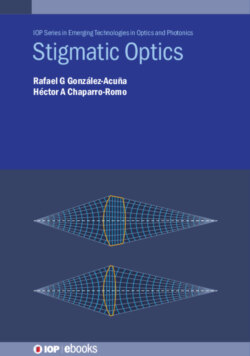Читать книгу Stigmatic Optics - Rafael G González-Acuña - Страница 19
На сайте Литреса книга снята с продажи.
1.8 The wave equation
ОглавлениеWe have briefly reviewed the Maxwell equations, but enough that from them, we can obtain the wave equation. So we recall the set of Maxwell equations, equations (1.8), (1.12) (1.14) and (1.17), as equation (1.18),
∇·E⃗=ρε0,∇·B⃗=0,∇×E⃗=−∂B⃗∂t,∇×B⃗=μ0J⃗+ε0∂E⃗∂t,(1.18)
If we apply the curl on Faraday’s law, equation (1.14), we get,
∇×(∇×E⃗)=∇×−∂B⃗∂t=−∂∇×B⃗∂t.(1.19)
Now, we use the vector calculus identity expressed in equation (1.20),
∇×(∇×A⃗)=∇(∇·A⃗)−∇2A⃗.(1.20)
Using the identify of equation (1.20), in equation (1.19),
∇×(∇×E⃗)=∇(∇·E⃗)−∇2E⃗=−∂∇×B⃗∂t.(1.21)
The last term of equation (1.21) can be replaced using Ampère’s law, equation (1.17),
∇×B⃗=μ0J⃗+ε0∂E⃗∂t,(1.17)
thus, replacing equation (1.17) in equation (1.21),
∇×(∇×E⃗)=∇(∇·E⃗)−∇2E⃗=−∂μ0J⃗+ε0∂E⃗∂t∂t.(1.22)
Now, with the Gauss law we can reformulate equation (1.22), thus let’s recall the Gauss law,
∇·E⃗=ρε0,(1.9)
replacing equation (1.8) in equation (1.22),
∇ρε0−∇2E⃗=−μ0∂J⃗∂t−μ0ε0∂2E⃗∂t2.(1.23)
If we are working in a charge- and current-free region, ρ=0 and J⃗=0, then equation (1.23) becomes,
∇2E⃗=μ0ε0∂2E⃗∂t2.(1.24)
Equation (1.24) is called the wave equation. The wave equation is an important second-order linear partial differential equation that describes the propagation of a variety of waves, such as sound waves, light waves, and waves in water. It is important in various fields such as acoustics, electromagnetism, quantum mechanics, and fluid dynamics. The form represented in equation (1.24) is for an electric field E⃗. But if we apply ∇⃗× to Ampère’s law, then apply a similar procedure we can get,
∇2B⃗=μ0ε0∂2B⃗∂t2.(1.25)
Equation (1.25) is the wave equation for B⃗. The process to get equation (1.25) is left as an exercise to the reader.
